HNC/HND Report: Supporting Independent Living and Assistive Tech
VerifiedAdded on 2020/06/04
|16
|4050
|28
Report
AI Summary
This report explores the use of technology to support independent living, focusing on the case of Sally, a 42-year-old woman with disabilities. It identifies various assistive technologies such as PocketCoach, spinner knobs, and special keyboards, highlighting their benefits in enhancing daily life and addressing memory issues. The report also discusses barriers to technology adoption, including resistance, budget constraints, and ethical considerations. Furthermore, it examines the health and safety aspects, emphasizing the importance of ethical considerations, such as autonomy and beneficence, in the application of assistive technologies. The impact of emerging technologies on healthcare organizations and workers, including both positive and negative consequences, is also assessed. Finally, the report recommends appropriate assistive devices and evaluates the usefulness of technologies for users of health and social care services, providing a comprehensive overview of technology's role in promoting independent living.

HNC/HND Supporting Independent
Living
Living
Paraphrase This Document
Need a fresh take? Get an instant paraphrase of this document with our AI Paraphraser
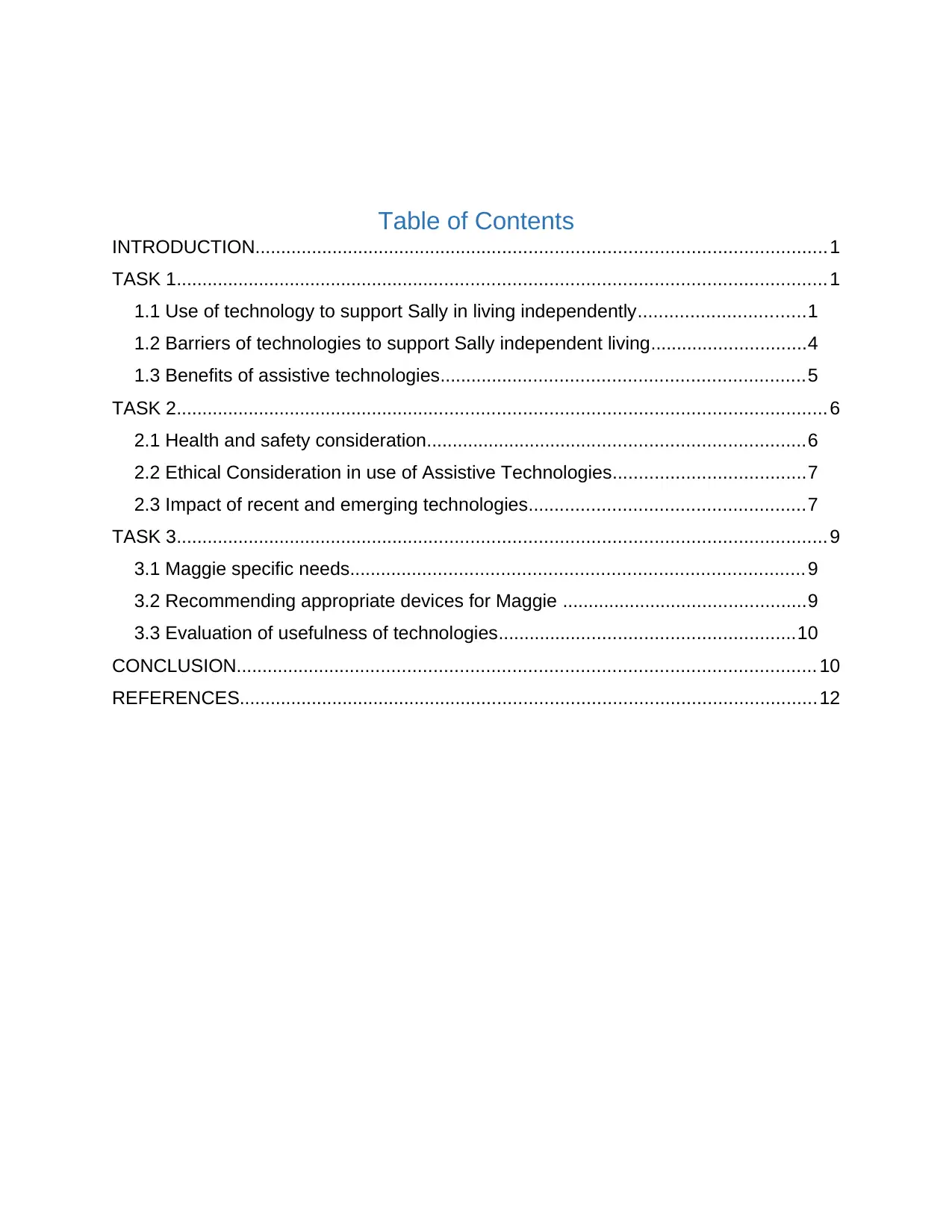
Table of Contents
INTRODUCTION..............................................................................................................1
TASK 1.............................................................................................................................1
1.1 Use of technology to support Sally in living independently................................1
1.2 Barriers of technologies to support Sally independent living..............................4
1.3 Benefits of assistive technologies......................................................................5
TASK 2.............................................................................................................................6
2.1 Health and safety consideration.........................................................................6
2.2 Ethical Consideration in use of Assistive Technologies.....................................7
2.3 Impact of recent and emerging technologies.....................................................7
TASK 3.............................................................................................................................9
3.1 Maggie specific needs....................................................................................... 9
3.2 Recommending appropriate devices for Maggie ...............................................9
3.3 Evaluation of usefulness of technologies.........................................................10
CONCLUSION............................................................................................................... 10
REFERENCES...............................................................................................................12
INTRODUCTION..............................................................................................................1
TASK 1.............................................................................................................................1
1.1 Use of technology to support Sally in living independently................................1
1.2 Barriers of technologies to support Sally independent living..............................4
1.3 Benefits of assistive technologies......................................................................5
TASK 2.............................................................................................................................6
2.1 Health and safety consideration.........................................................................6
2.2 Ethical Consideration in use of Assistive Technologies.....................................7
2.3 Impact of recent and emerging technologies.....................................................7
TASK 3.............................................................................................................................9
3.1 Maggie specific needs....................................................................................... 9
3.2 Recommending appropriate devices for Maggie ...............................................9
3.3 Evaluation of usefulness of technologies.........................................................10
CONCLUSION............................................................................................................... 10
REFERENCES...............................................................................................................12
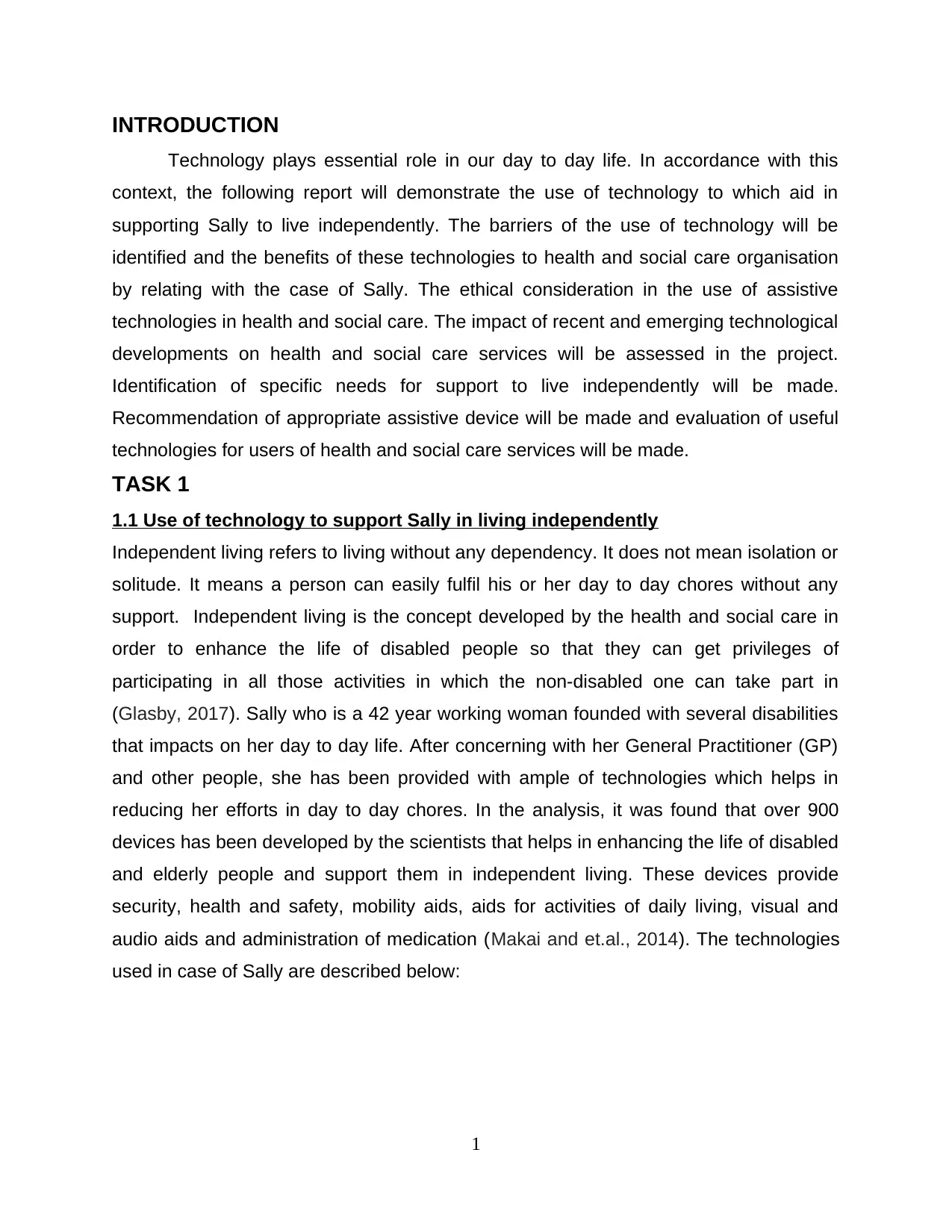
INTRODUCTION
Technology plays essential role in our day to day life. In accordance with this
context, the following report will demonstrate the use of technology to which aid in
supporting Sally to live independently. The barriers of the use of technology will be
identified and the benefits of these technologies to health and social care organisation
by relating with the case of Sally. The ethical consideration in the use of assistive
technologies in health and social care. The impact of recent and emerging technological
developments on health and social care services will be assessed in the project.
Identification of specific needs for support to live independently will be made.
Recommendation of appropriate assistive device will be made and evaluation of useful
technologies for users of health and social care services will be made.
TASK 1
1.1 Use of technology to support Sally in living independently
Independent living refers to living without any dependency. It does not mean isolation or
solitude. It means a person can easily fulfil his or her day to day chores without any
support. Independent living is the concept developed by the health and social care in
order to enhance the life of disabled people so that they can get privileges of
participating in all those activities in which the non-disabled one can take part in
(Glasby, 2017). Sally who is a 42 year working woman founded with several disabilities
that impacts on her day to day life. After concerning with her General Practitioner (GP)
and other people, she has been provided with ample of technologies which helps in
reducing her efforts in day to day chores. In the analysis, it was found that over 900
devices has been developed by the scientists that helps in enhancing the life of disabled
and elderly people and support them in independent living. These devices provide
security, health and safety, mobility aids, aids for activities of daily living, visual and
audio aids and administration of medication (Makai and et.al., 2014). The technologies
used in case of Sally are described below:
1
Technology plays essential role in our day to day life. In accordance with this
context, the following report will demonstrate the use of technology to which aid in
supporting Sally to live independently. The barriers of the use of technology will be
identified and the benefits of these technologies to health and social care organisation
by relating with the case of Sally. The ethical consideration in the use of assistive
technologies in health and social care. The impact of recent and emerging technological
developments on health and social care services will be assessed in the project.
Identification of specific needs for support to live independently will be made.
Recommendation of appropriate assistive device will be made and evaluation of useful
technologies for users of health and social care services will be made.
TASK 1
1.1 Use of technology to support Sally in living independently
Independent living refers to living without any dependency. It does not mean isolation or
solitude. It means a person can easily fulfil his or her day to day chores without any
support. Independent living is the concept developed by the health and social care in
order to enhance the life of disabled people so that they can get privileges of
participating in all those activities in which the non-disabled one can take part in
(Glasby, 2017). Sally who is a 42 year working woman founded with several disabilities
that impacts on her day to day life. After concerning with her General Practitioner (GP)
and other people, she has been provided with ample of technologies which helps in
reducing her efforts in day to day chores. In the analysis, it was found that over 900
devices has been developed by the scientists that helps in enhancing the life of disabled
and elderly people and support them in independent living. These devices provide
security, health and safety, mobility aids, aids for activities of daily living, visual and
audio aids and administration of medication (Makai and et.al., 2014). The technologies
used in case of Sally are described below:
1
⊘ This is a preview!⊘
Do you want full access?
Subscribe today to unlock all pages.

Trusted by 1+ million students worldwide
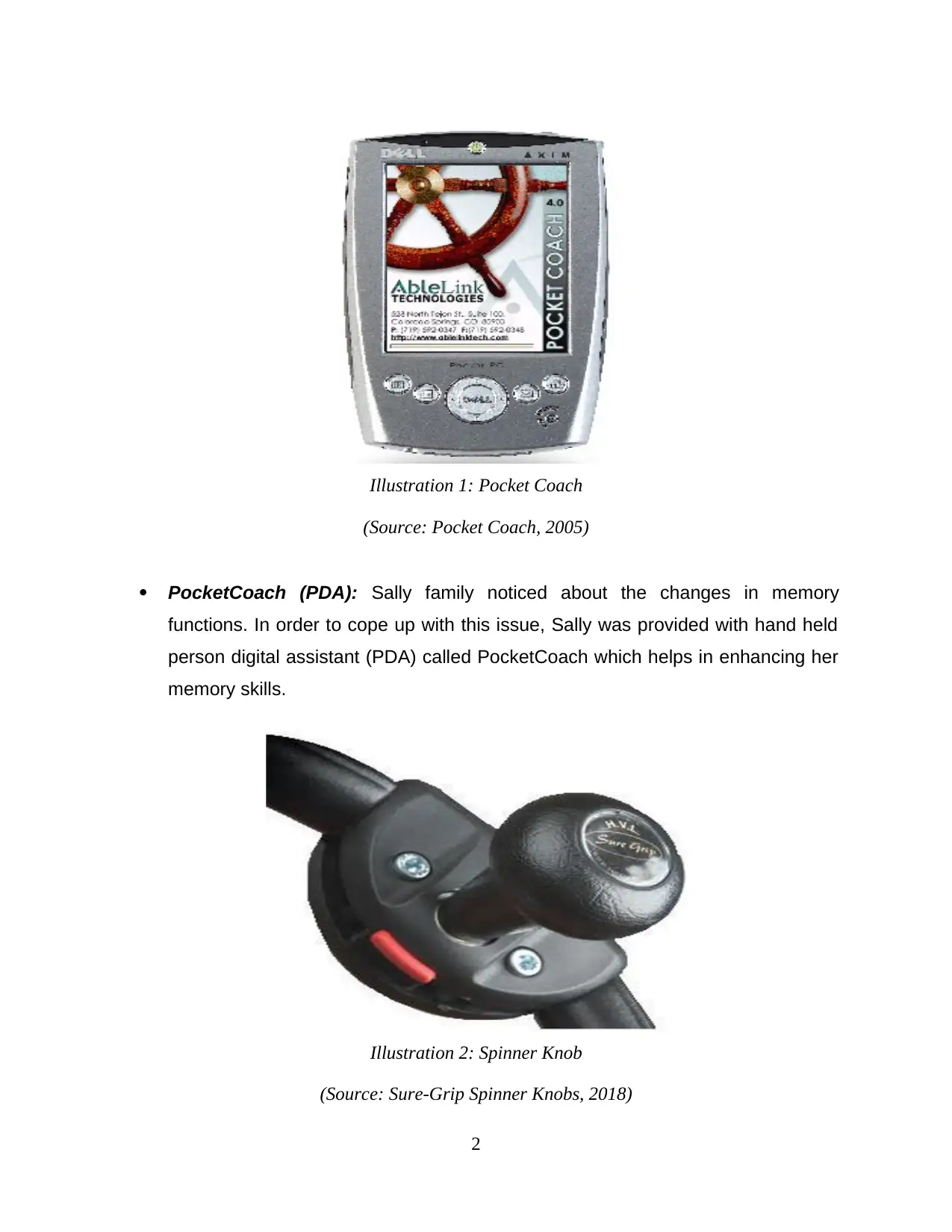
PocketCoach (PDA): Sally family noticed about the changes in memory
functions. In order to cope up with this issue, Sally was provided with hand held
person digital assistant (PDA) called PocketCoach which helps in enhancing her
memory skills.
2
Illustration 1: Pocket Coach
(Source: Pocket Coach, 2005)
Illustration 2: Spinner Knob
(Source: Sure-Grip Spinner Knobs, 2018)
functions. In order to cope up with this issue, Sally was provided with hand held
person digital assistant (PDA) called PocketCoach which helps in enhancing her
memory skills.
2
Illustration 1: Pocket Coach
(Source: Pocket Coach, 2005)
Illustration 2: Spinner Knob
(Source: Sure-Grip Spinner Knobs, 2018)
Paraphrase This Document
Need a fresh take? Get an instant paraphrase of this document with our AI Paraphraser
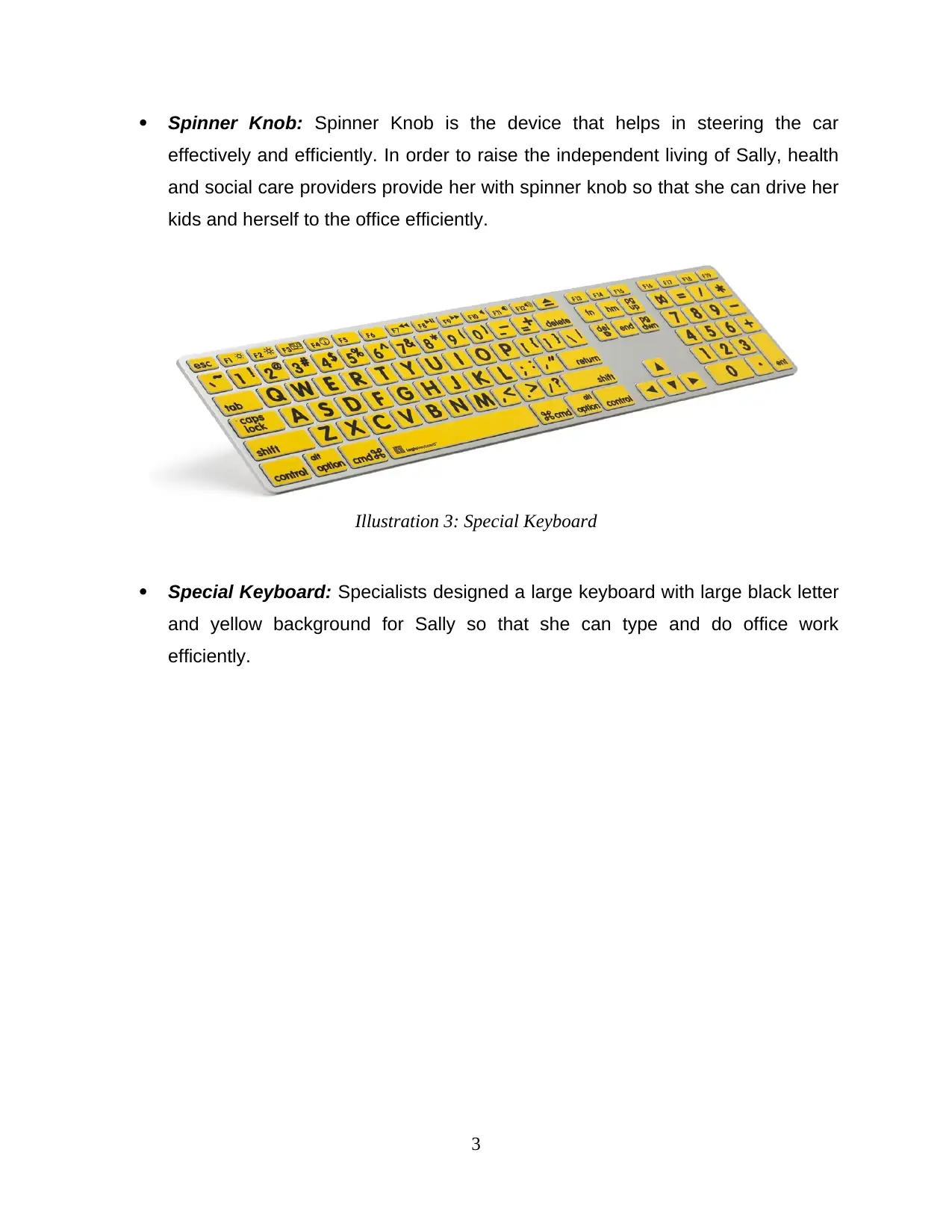
Spinner Knob: Spinner Knob is the device that helps in steering the car
effectively and efficiently. In order to raise the independent living of Sally, health
and social care providers provide her with spinner knob so that she can drive her
kids and herself to the office efficiently.
Special Keyboard: Specialists designed a large keyboard with large black letter
and yellow background for Sally so that she can type and do office work
efficiently.
3
Illustration 3: Special Keyboard
effectively and efficiently. In order to raise the independent living of Sally, health
and social care providers provide her with spinner knob so that she can drive her
kids and herself to the office efficiently.
Special Keyboard: Specialists designed a large keyboard with large black letter
and yellow background for Sally so that she can type and do office work
efficiently.
3
Illustration 3: Special Keyboard
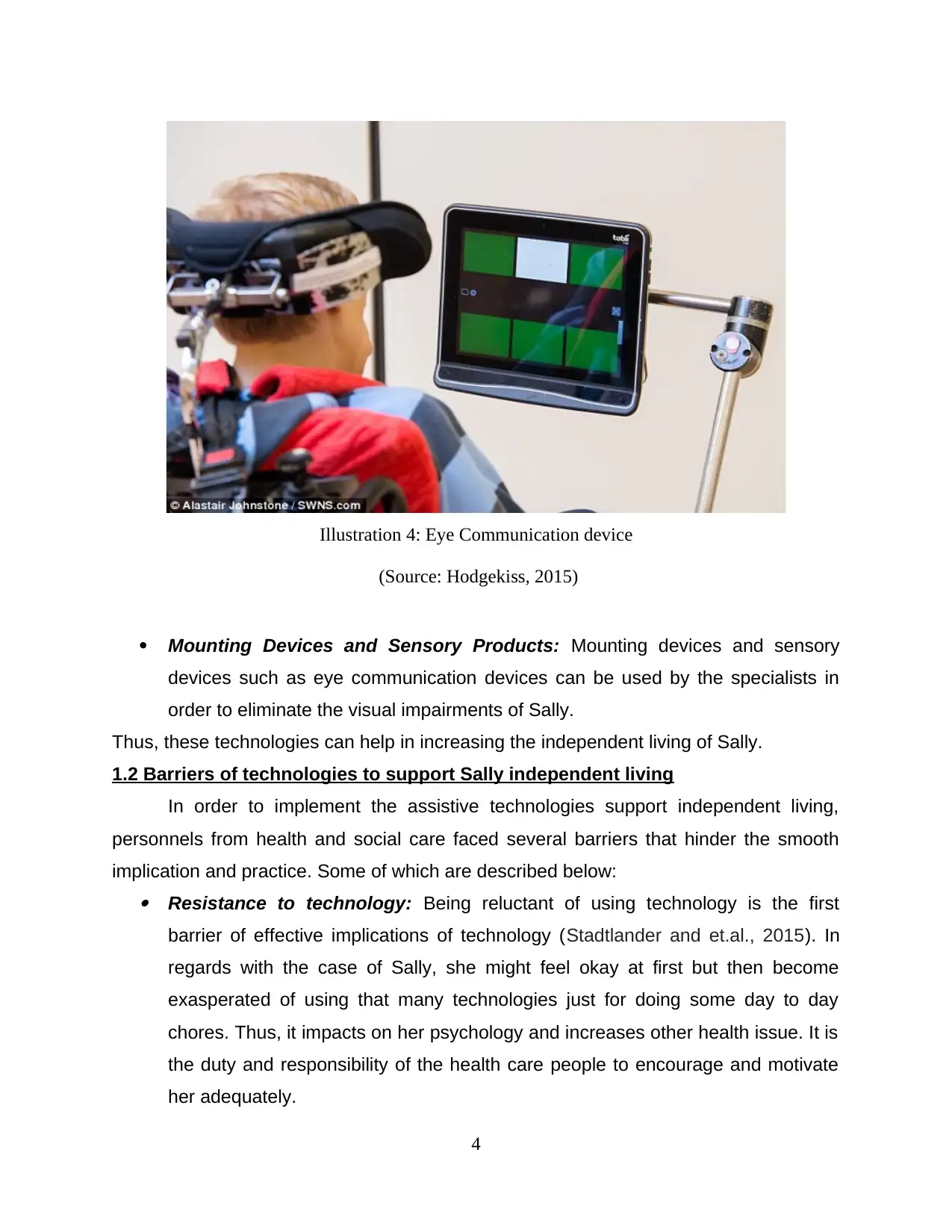
Mounting Devices and Sensory Products: Mounting devices and sensory
devices such as eye communication devices can be used by the specialists in
order to eliminate the visual impairments of Sally.
Thus, these technologies can help in increasing the independent living of Sally.
1.2 Barriers of technologies to support Sally independent living
In order to implement the assistive technologies support independent living,
personnels from health and social care faced several barriers that hinder the smooth
implication and practice. Some of which are described below: Resistance to technology: Being reluctant of using technology is the first
barrier of effective implications of technology (Stadtlander and et.al., 2015). In
regards with the case of Sally, she might feel okay at first but then become
exasperated of using that many technologies just for doing some day to day
chores. Thus, it impacts on her psychology and increases other health issue. It is
the duty and responsibility of the health care people to encourage and motivate
her adequately.
4
Illustration 4: Eye Communication device
(Source: Hodgekiss, 2015)
devices such as eye communication devices can be used by the specialists in
order to eliminate the visual impairments of Sally.
Thus, these technologies can help in increasing the independent living of Sally.
1.2 Barriers of technologies to support Sally independent living
In order to implement the assistive technologies support independent living,
personnels from health and social care faced several barriers that hinder the smooth
implication and practice. Some of which are described below: Resistance to technology: Being reluctant of using technology is the first
barrier of effective implications of technology (Stadtlander and et.al., 2015). In
regards with the case of Sally, she might feel okay at first but then become
exasperated of using that many technologies just for doing some day to day
chores. Thus, it impacts on her psychology and increases other health issue. It is
the duty and responsibility of the health care people to encourage and motivate
her adequately.
4
Illustration 4: Eye Communication device
(Source: Hodgekiss, 2015)
⊘ This is a preview!⊘
Do you want full access?
Subscribe today to unlock all pages.

Trusted by 1+ million students worldwide
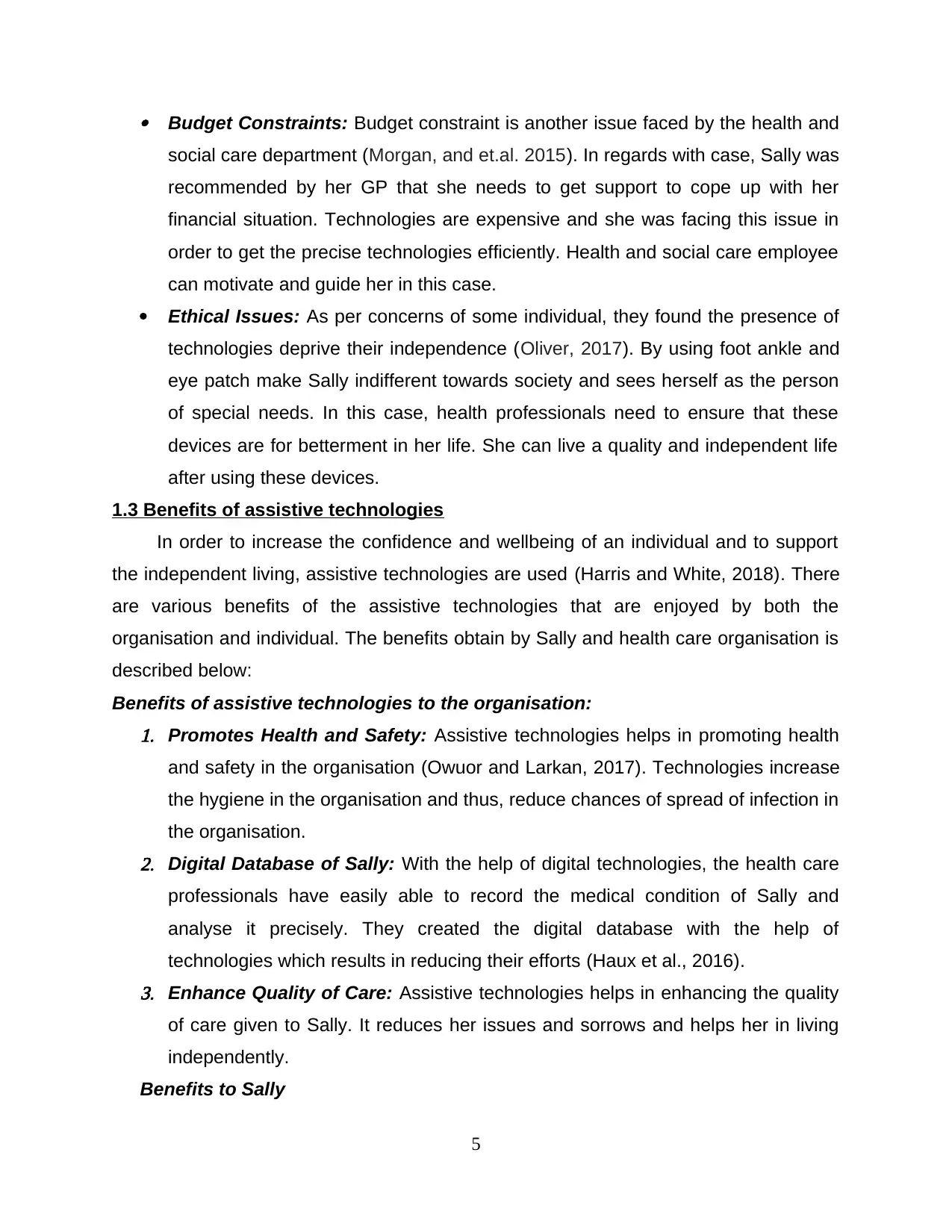
Budget Constraints: Budget constraint is another issue faced by the health and
social care department (Morgan, and et.al. 2015). In regards with case, Sally was
recommended by her GP that she needs to get support to cope up with her
financial situation. Technologies are expensive and she was facing this issue in
order to get the precise technologies efficiently. Health and social care employee
can motivate and guide her in this case.
Ethical Issues: As per concerns of some individual, they found the presence of
technologies deprive their independence (Oliver, 2017). By using foot ankle and
eye patch make Sally indifferent towards society and sees herself as the person
of special needs. In this case, health professionals need to ensure that these
devices are for betterment in her life. She can live a quality and independent life
after using these devices.
1.3 Benefits of assistive technologies
In order to increase the confidence and wellbeing of an individual and to support
the independent living, assistive technologies are used (Harris and White, 2018). There
are various benefits of the assistive technologies that are enjoyed by both the
organisation and individual. The benefits obtain by Sally and health care organisation is
described below:
Benefits of assistive technologies to the organisation:1. Promotes Health and Safety: Assistive technologies helps in promoting health
and safety in the organisation (Owuor and Larkan, 2017). Technologies increase
the hygiene in the organisation and thus, reduce chances of spread of infection in
the organisation.2. Digital Database of Sally: With the help of digital technologies, the health care
professionals have easily able to record the medical condition of Sally and
analyse it precisely. They created the digital database with the help of
technologies which results in reducing their efforts (Haux et al., 2016).3. Enhance Quality of Care: Assistive technologies helps in enhancing the quality
of care given to Sally. It reduces her issues and sorrows and helps her in living
independently.
Benefits to Sally
5
social care department (Morgan, and et.al. 2015). In regards with case, Sally was
recommended by her GP that she needs to get support to cope up with her
financial situation. Technologies are expensive and she was facing this issue in
order to get the precise technologies efficiently. Health and social care employee
can motivate and guide her in this case.
Ethical Issues: As per concerns of some individual, they found the presence of
technologies deprive their independence (Oliver, 2017). By using foot ankle and
eye patch make Sally indifferent towards society and sees herself as the person
of special needs. In this case, health professionals need to ensure that these
devices are for betterment in her life. She can live a quality and independent life
after using these devices.
1.3 Benefits of assistive technologies
In order to increase the confidence and wellbeing of an individual and to support
the independent living, assistive technologies are used (Harris and White, 2018). There
are various benefits of the assistive technologies that are enjoyed by both the
organisation and individual. The benefits obtain by Sally and health care organisation is
described below:
Benefits of assistive technologies to the organisation:1. Promotes Health and Safety: Assistive technologies helps in promoting health
and safety in the organisation (Owuor and Larkan, 2017). Technologies increase
the hygiene in the organisation and thus, reduce chances of spread of infection in
the organisation.2. Digital Database of Sally: With the help of digital technologies, the health care
professionals have easily able to record the medical condition of Sally and
analyse it precisely. They created the digital database with the help of
technologies which results in reducing their efforts (Haux et al., 2016).3. Enhance Quality of Care: Assistive technologies helps in enhancing the quality
of care given to Sally. It reduces her issues and sorrows and helps her in living
independently.
Benefits to Sally
5
Paraphrase This Document
Need a fresh take? Get an instant paraphrase of this document with our AI Paraphraser
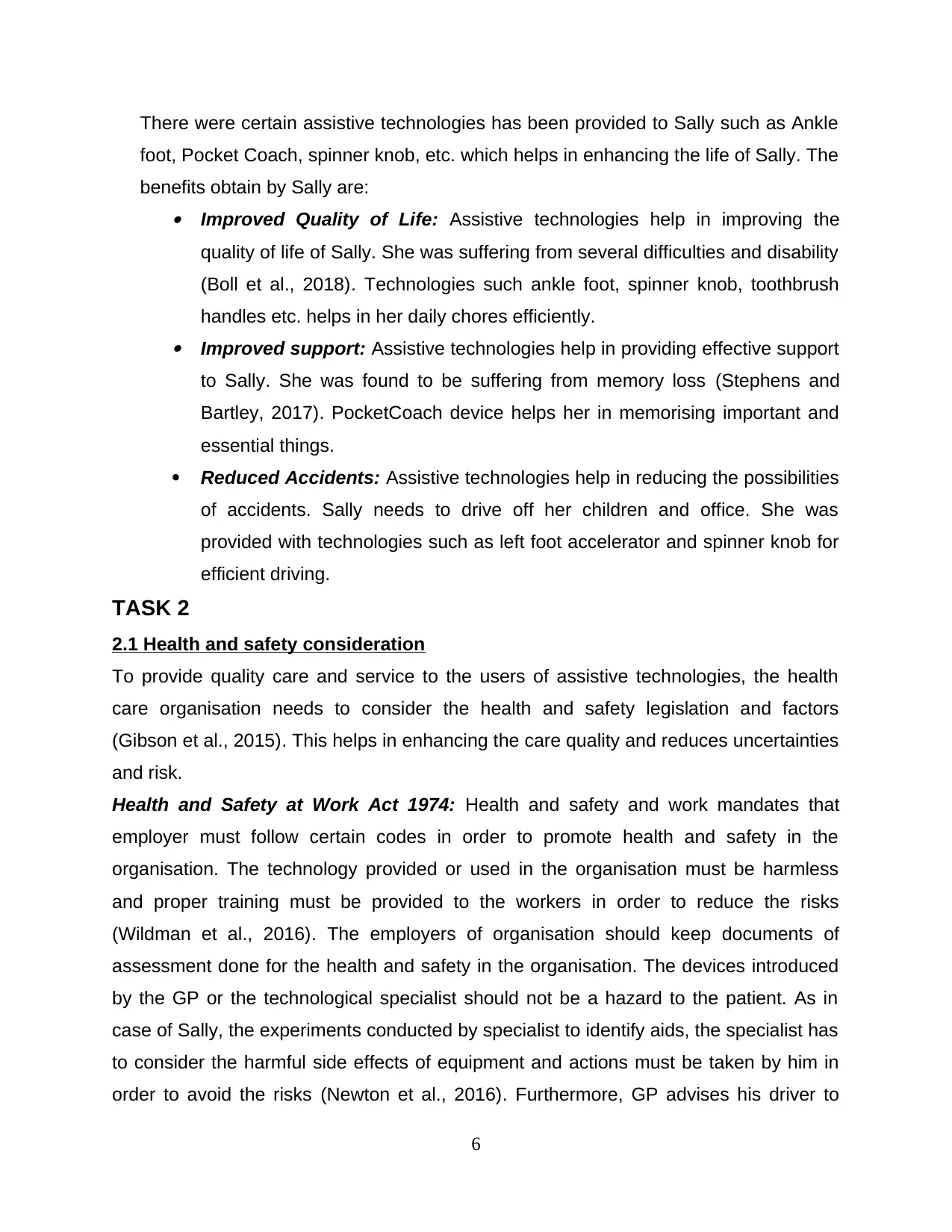
There were certain assistive technologies has been provided to Sally such as Ankle
foot, Pocket Coach, spinner knob, etc. which helps in enhancing the life of Sally. The
benefits obtain by Sally are:
Improved Quality of Life: Assistive technologies help in improving the
quality of life of Sally. She was suffering from several difficulties and disability
(Boll et al., 2018). Technologies such ankle foot, spinner knob, toothbrush
handles etc. helps in her daily chores efficiently.
Improved support: Assistive technologies help in providing effective support
to Sally. She was found to be suffering from memory loss (Stephens and
Bartley, 2017). PocketCoach device helps her in memorising important and
essential things.
Reduced Accidents: Assistive technologies help in reducing the possibilities
of accidents. Sally needs to drive off her children and office. She was
provided with technologies such as left foot accelerator and spinner knob for
efficient driving.
TASK 2
2.1 Health and safety consideration
To provide quality care and service to the users of assistive technologies, the health
care organisation needs to consider the health and safety legislation and factors
(Gibson et al., 2015). This helps in enhancing the care quality and reduces uncertainties
and risk.
Health and Safety at Work Act 1974: Health and safety and work mandates that
employer must follow certain codes in order to promote health and safety in the
organisation. The technology provided or used in the organisation must be harmless
and proper training must be provided to the workers in order to reduce the risks
(Wildman et al., 2016). The employers of organisation should keep documents of
assessment done for the health and safety in the organisation. The devices introduced
by the GP or the technological specialist should not be a hazard to the patient. As in
case of Sally, the experiments conducted by specialist to identify aids, the specialist has
to consider the harmful side effects of equipment and actions must be taken by him in
order to avoid the risks (Newton et al., 2016). Furthermore, GP advises his driver to
6
foot, Pocket Coach, spinner knob, etc. which helps in enhancing the life of Sally. The
benefits obtain by Sally are:
Improved Quality of Life: Assistive technologies help in improving the
quality of life of Sally. She was suffering from several difficulties and disability
(Boll et al., 2018). Technologies such ankle foot, spinner knob, toothbrush
handles etc. helps in her daily chores efficiently.
Improved support: Assistive technologies help in providing effective support
to Sally. She was found to be suffering from memory loss (Stephens and
Bartley, 2017). PocketCoach device helps her in memorising important and
essential things.
Reduced Accidents: Assistive technologies help in reducing the possibilities
of accidents. Sally needs to drive off her children and office. She was
provided with technologies such as left foot accelerator and spinner knob for
efficient driving.
TASK 2
2.1 Health and safety consideration
To provide quality care and service to the users of assistive technologies, the health
care organisation needs to consider the health and safety legislation and factors
(Gibson et al., 2015). This helps in enhancing the care quality and reduces uncertainties
and risk.
Health and Safety at Work Act 1974: Health and safety and work mandates that
employer must follow certain codes in order to promote health and safety in the
organisation. The technology provided or used in the organisation must be harmless
and proper training must be provided to the workers in order to reduce the risks
(Wildman et al., 2016). The employers of organisation should keep documents of
assessment done for the health and safety in the organisation. The devices introduced
by the GP or the technological specialist should not be a hazard to the patient. As in
case of Sally, the experiments conducted by specialist to identify aids, the specialist has
to consider the harmful side effects of equipment and actions must be taken by him in
order to avoid the risks (Newton et al., 2016). Furthermore, GP advises his driver to
6

adapt Sally vehicle with a spinner knob and left foot accelerator in order to provide
effective training and following all the regulations prescribed by government of United
Kingdom. Proper communication is important and it is the responsibility of GP to
communicate about the use of technology introduced to Sally.
2.2 Ethical Consideration in use of Assistive Technologies
While using and providing assistive technologies, numerous ethics and ethical
consideration must be consider by health and social care providers (McDermott and
Tait, 2015). The mandatory and valuable ethics in health and social care is Autonomy or
ability of an individual to make choices. In case of Sally, the duty of GP is to provide
opportunity to Sally to make choices whether she wants to use assistive technologies or
not. Another ethic in health and social care is Beneficence or the principle of working for
benefits of the individual. GP should not work in order to gain profits and revenue, rather
they have to work to provide benefits to Sally and reduce her issue by providing precise
assistive technologies. Another ethics of non-maleficence which mean principle of doing
no harm must be followed by the health and social care organisation (Garçon et al.,
2016). In case of Sally, the GP should be careful about the technological solutions they
prescribed to Sally.
They must be assured about the technologies after conducting several experiments.
Health and social care staffs need to practice in judging on the moral obligation to act
on a fair negotiation between conflicting claims. In case of Sally, if the professional had
made some mistake, then he or she must take precise step in order to obliterate the
mistake (Gibson et al., 2016). The health and social care practitioners and professionals
need to check the quality of technologies on regular basis in order to ensure the safety
of technologies. In case of Sally, it is the duty and moral obligation of the workers to
check the devices time to time in order to avoid any risk or uncertainties.
2.3 Impact of recent and emerging technologies
The motive of using assistive technologies is to support the independent living of the
service users. In this context, the impact of recent and emerging technologies on health
and social care, organisation and workers are described below:
Positive Impact on organisation and care services
7
effective training and following all the regulations prescribed by government of United
Kingdom. Proper communication is important and it is the responsibility of GP to
communicate about the use of technology introduced to Sally.
2.2 Ethical Consideration in use of Assistive Technologies
While using and providing assistive technologies, numerous ethics and ethical
consideration must be consider by health and social care providers (McDermott and
Tait, 2015). The mandatory and valuable ethics in health and social care is Autonomy or
ability of an individual to make choices. In case of Sally, the duty of GP is to provide
opportunity to Sally to make choices whether she wants to use assistive technologies or
not. Another ethic in health and social care is Beneficence or the principle of working for
benefits of the individual. GP should not work in order to gain profits and revenue, rather
they have to work to provide benefits to Sally and reduce her issue by providing precise
assistive technologies. Another ethics of non-maleficence which mean principle of doing
no harm must be followed by the health and social care organisation (Garçon et al.,
2016). In case of Sally, the GP should be careful about the technological solutions they
prescribed to Sally.
They must be assured about the technologies after conducting several experiments.
Health and social care staffs need to practice in judging on the moral obligation to act
on a fair negotiation between conflicting claims. In case of Sally, if the professional had
made some mistake, then he or she must take precise step in order to obliterate the
mistake (Gibson et al., 2016). The health and social care practitioners and professionals
need to check the quality of technologies on regular basis in order to ensure the safety
of technologies. In case of Sally, it is the duty and moral obligation of the workers to
check the devices time to time in order to avoid any risk or uncertainties.
2.3 Impact of recent and emerging technologies
The motive of using assistive technologies is to support the independent living of the
service users. In this context, the impact of recent and emerging technologies on health
and social care, organisation and workers are described below:
Positive Impact on organisation and care services
7
⊘ This is a preview!⊘
Do you want full access?
Subscribe today to unlock all pages.

Trusted by 1+ million students worldwide
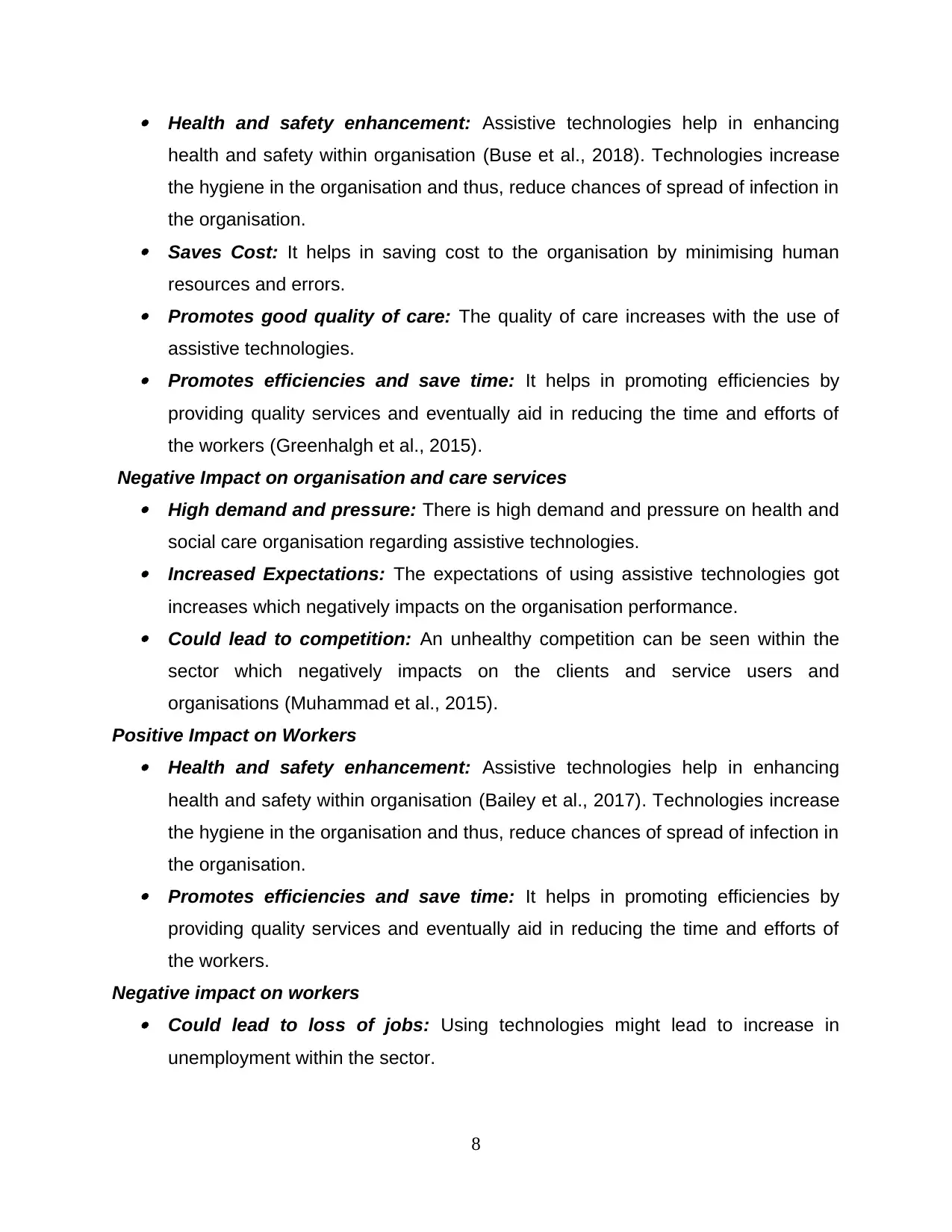
Health and safety enhancement: Assistive technologies help in enhancing
health and safety within organisation (Buse et al., 2018). Technologies increase
the hygiene in the organisation and thus, reduce chances of spread of infection in
the organisation. Saves Cost: It helps in saving cost to the organisation by minimising human
resources and errors. Promotes good quality of care: The quality of care increases with the use of
assistive technologies. Promotes efficiencies and save time: It helps in promoting efficiencies by
providing quality services and eventually aid in reducing the time and efforts of
the workers (Greenhalgh et al., 2015).
Negative Impact on organisation and care services High demand and pressure: There is high demand and pressure on health and
social care organisation regarding assistive technologies. Increased Expectations: The expectations of using assistive technologies got
increases which negatively impacts on the organisation performance. Could lead to competition: An unhealthy competition can be seen within the
sector which negatively impacts on the clients and service users and
organisations (Muhammad et al., 2015).
Positive Impact on Workers Health and safety enhancement: Assistive technologies help in enhancing
health and safety within organisation (Bailey et al., 2017). Technologies increase
the hygiene in the organisation and thus, reduce chances of spread of infection in
the organisation. Promotes efficiencies and save time: It helps in promoting efficiencies by
providing quality services and eventually aid in reducing the time and efforts of
the workers.
Negative impact on workers Could lead to loss of jobs: Using technologies might lead to increase in
unemployment within the sector.
8
health and safety within organisation (Buse et al., 2018). Technologies increase
the hygiene in the organisation and thus, reduce chances of spread of infection in
the organisation. Saves Cost: It helps in saving cost to the organisation by minimising human
resources and errors. Promotes good quality of care: The quality of care increases with the use of
assistive technologies. Promotes efficiencies and save time: It helps in promoting efficiencies by
providing quality services and eventually aid in reducing the time and efforts of
the workers (Greenhalgh et al., 2015).
Negative Impact on organisation and care services High demand and pressure: There is high demand and pressure on health and
social care organisation regarding assistive technologies. Increased Expectations: The expectations of using assistive technologies got
increases which negatively impacts on the organisation performance. Could lead to competition: An unhealthy competition can be seen within the
sector which negatively impacts on the clients and service users and
organisations (Muhammad et al., 2015).
Positive Impact on Workers Health and safety enhancement: Assistive technologies help in enhancing
health and safety within organisation (Bailey et al., 2017). Technologies increase
the hygiene in the organisation and thus, reduce chances of spread of infection in
the organisation. Promotes efficiencies and save time: It helps in promoting efficiencies by
providing quality services and eventually aid in reducing the time and efforts of
the workers.
Negative impact on workers Could lead to loss of jobs: Using technologies might lead to increase in
unemployment within the sector.
8
Paraphrase This Document
Need a fresh take? Get an instant paraphrase of this document with our AI Paraphraser
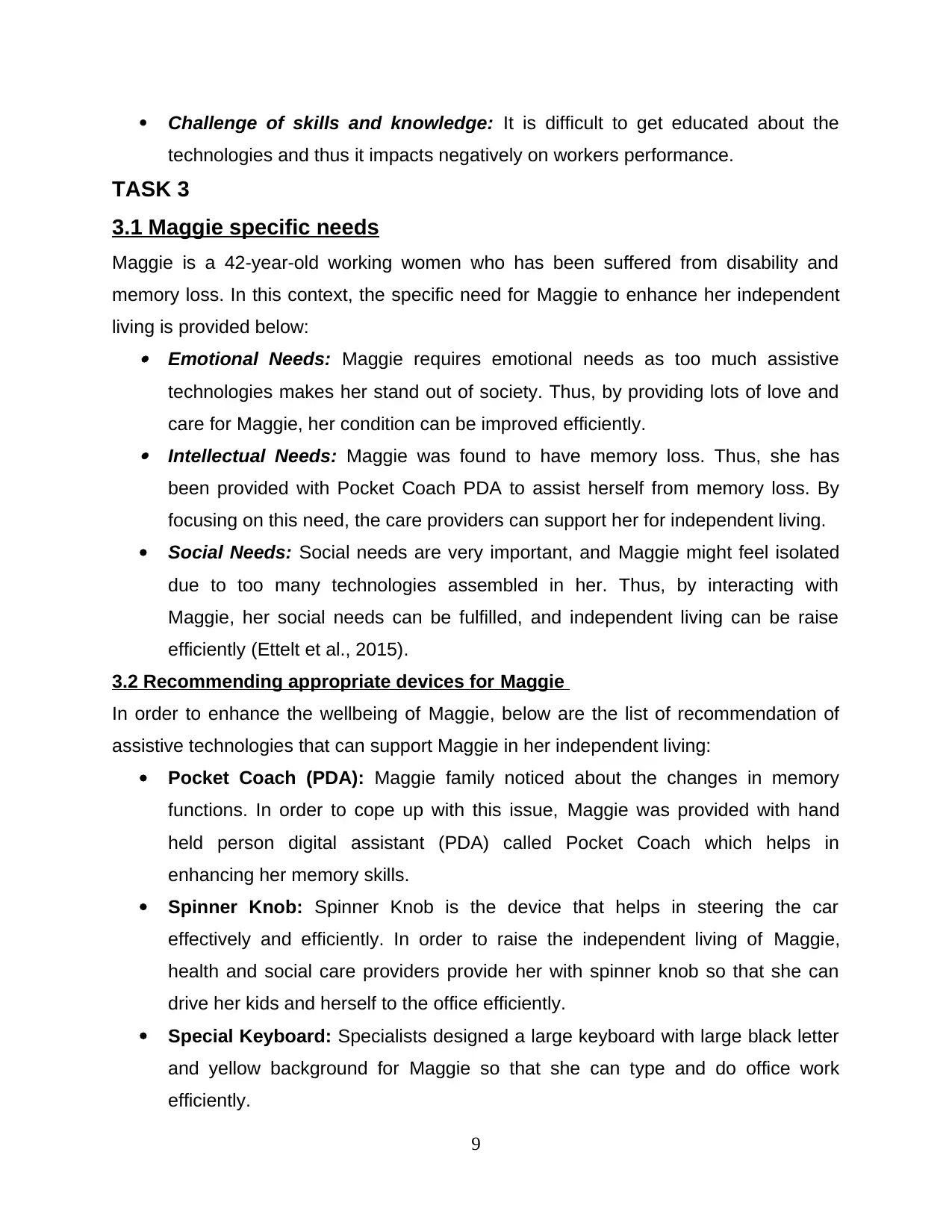
Challenge of skills and knowledge: It is difficult to get educated about the
technologies and thus it impacts negatively on workers performance.
TASK 3
3.1 Maggie specific needs
Maggie is a 42-year-old working women who has been suffered from disability and
memory loss. In this context, the specific need for Maggie to enhance her independent
living is provided below: Emotional Needs: Maggie requires emotional needs as too much assistive
technologies makes her stand out of society. Thus, by providing lots of love and
care for Maggie, her condition can be improved efficiently. Intellectual Needs: Maggie was found to have memory loss. Thus, she has
been provided with Pocket Coach PDA to assist herself from memory loss. By
focusing on this need, the care providers can support her for independent living.
Social Needs: Social needs are very important, and Maggie might feel isolated
due to too many technologies assembled in her. Thus, by interacting with
Maggie, her social needs can be fulfilled, and independent living can be raise
efficiently (Ettelt et al., 2015).
3.2 Recommending appropriate devices for Maggie
In order to enhance the wellbeing of Maggie, below are the list of recommendation of
assistive technologies that can support Maggie in her independent living:
Pocket Coach (PDA): Maggie family noticed about the changes in memory
functions. In order to cope up with this issue, Maggie was provided with hand
held person digital assistant (PDA) called Pocket Coach which helps in
enhancing her memory skills.
Spinner Knob: Spinner Knob is the device that helps in steering the car
effectively and efficiently. In order to raise the independent living of Maggie,
health and social care providers provide her with spinner knob so that she can
drive her kids and herself to the office efficiently.
Special Keyboard: Specialists designed a large keyboard with large black letter
and yellow background for Maggie so that she can type and do office work
efficiently.
9
technologies and thus it impacts negatively on workers performance.
TASK 3
3.1 Maggie specific needs
Maggie is a 42-year-old working women who has been suffered from disability and
memory loss. In this context, the specific need for Maggie to enhance her independent
living is provided below: Emotional Needs: Maggie requires emotional needs as too much assistive
technologies makes her stand out of society. Thus, by providing lots of love and
care for Maggie, her condition can be improved efficiently. Intellectual Needs: Maggie was found to have memory loss. Thus, she has
been provided with Pocket Coach PDA to assist herself from memory loss. By
focusing on this need, the care providers can support her for independent living.
Social Needs: Social needs are very important, and Maggie might feel isolated
due to too many technologies assembled in her. Thus, by interacting with
Maggie, her social needs can be fulfilled, and independent living can be raise
efficiently (Ettelt et al., 2015).
3.2 Recommending appropriate devices for Maggie
In order to enhance the wellbeing of Maggie, below are the list of recommendation of
assistive technologies that can support Maggie in her independent living:
Pocket Coach (PDA): Maggie family noticed about the changes in memory
functions. In order to cope up with this issue, Maggie was provided with hand
held person digital assistant (PDA) called Pocket Coach which helps in
enhancing her memory skills.
Spinner Knob: Spinner Knob is the device that helps in steering the car
effectively and efficiently. In order to raise the independent living of Maggie,
health and social care providers provide her with spinner knob so that she can
drive her kids and herself to the office efficiently.
Special Keyboard: Specialists designed a large keyboard with large black letter
and yellow background for Maggie so that she can type and do office work
efficiently.
9
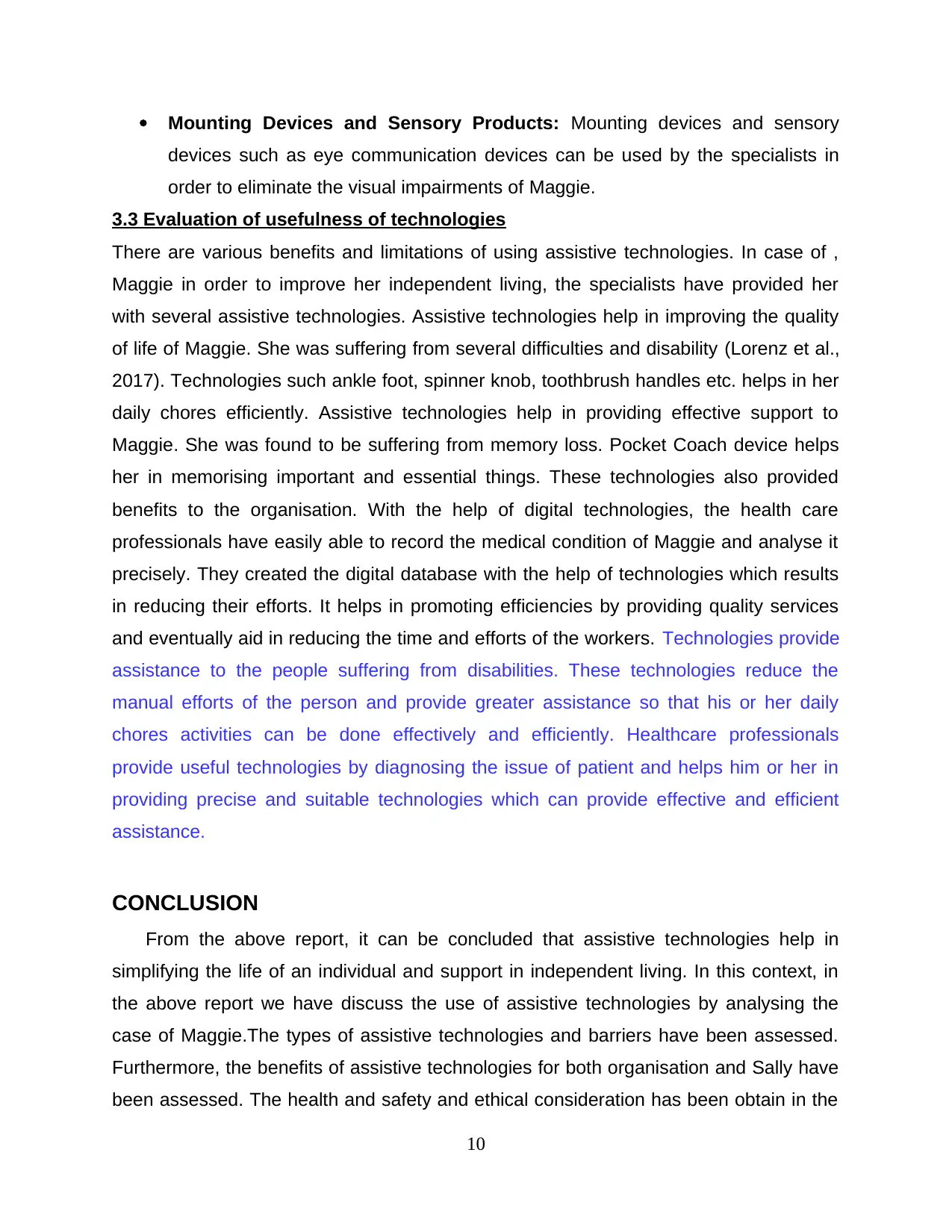
Mounting Devices and Sensory Products: Mounting devices and sensory
devices such as eye communication devices can be used by the specialists in
order to eliminate the visual impairments of Maggie.
3.3 Evaluation of usefulness of technologies
There are various benefits and limitations of using assistive technologies. In case of ,
Maggie in order to improve her independent living, the specialists have provided her
with several assistive technologies. Assistive technologies help in improving the quality
of life of Maggie. She was suffering from several difficulties and disability (Lorenz et al.,
2017). Technologies such ankle foot, spinner knob, toothbrush handles etc. helps in her
daily chores efficiently. Assistive technologies help in providing effective support to
Maggie. She was found to be suffering from memory loss. Pocket Coach device helps
her in memorising important and essential things. These technologies also provided
benefits to the organisation. With the help of digital technologies, the health care
professionals have easily able to record the medical condition of Maggie and analyse it
precisely. They created the digital database with the help of technologies which results
in reducing their efforts. It helps in promoting efficiencies by providing quality services
and eventually aid in reducing the time and efforts of the workers. Technologies provide
assistance to the people suffering from disabilities. These technologies reduce the
manual efforts of the person and provide greater assistance so that his or her daily
chores activities can be done effectively and efficiently. Healthcare professionals
provide useful technologies by diagnosing the issue of patient and helps him or her in
providing precise and suitable technologies which can provide effective and efficient
assistance.
CONCLUSION
From the above report, it can be concluded that assistive technologies help in
simplifying the life of an individual and support in independent living. In this context, in
the above report we have discuss the use of assistive technologies by analysing the
case of Maggie.The types of assistive technologies and barriers have been assessed.
Furthermore, the benefits of assistive technologies for both organisation and Sally have
been assessed. The health and safety and ethical consideration has been obtain in the
10
devices such as eye communication devices can be used by the specialists in
order to eliminate the visual impairments of Maggie.
3.3 Evaluation of usefulness of technologies
There are various benefits and limitations of using assistive technologies. In case of ,
Maggie in order to improve her independent living, the specialists have provided her
with several assistive technologies. Assistive technologies help in improving the quality
of life of Maggie. She was suffering from several difficulties and disability (Lorenz et al.,
2017). Technologies such ankle foot, spinner knob, toothbrush handles etc. helps in her
daily chores efficiently. Assistive technologies help in providing effective support to
Maggie. She was found to be suffering from memory loss. Pocket Coach device helps
her in memorising important and essential things. These technologies also provided
benefits to the organisation. With the help of digital technologies, the health care
professionals have easily able to record the medical condition of Maggie and analyse it
precisely. They created the digital database with the help of technologies which results
in reducing their efforts. It helps in promoting efficiencies by providing quality services
and eventually aid in reducing the time and efforts of the workers. Technologies provide
assistance to the people suffering from disabilities. These technologies reduce the
manual efforts of the person and provide greater assistance so that his or her daily
chores activities can be done effectively and efficiently. Healthcare professionals
provide useful technologies by diagnosing the issue of patient and helps him or her in
providing precise and suitable technologies which can provide effective and efficient
assistance.
CONCLUSION
From the above report, it can be concluded that assistive technologies help in
simplifying the life of an individual and support in independent living. In this context, in
the above report we have discuss the use of assistive technologies by analysing the
case of Maggie.The types of assistive technologies and barriers have been assessed.
Furthermore, the benefits of assistive technologies for both organisation and Sally have
been assessed. The health and safety and ethical consideration has been obtain in the
10
⊘ This is a preview!⊘
Do you want full access?
Subscribe today to unlock all pages.

Trusted by 1+ million students worldwide
1 out of 16
Related Documents
Your All-in-One AI-Powered Toolkit for Academic Success.
+13062052269
info@desklib.com
Available 24*7 on WhatsApp / Email
![[object Object]](/_next/static/media/star-bottom.7253800d.svg)
Unlock your academic potential
Copyright © 2020–2025 A2Z Services. All Rights Reserved. Developed and managed by ZUCOL.





